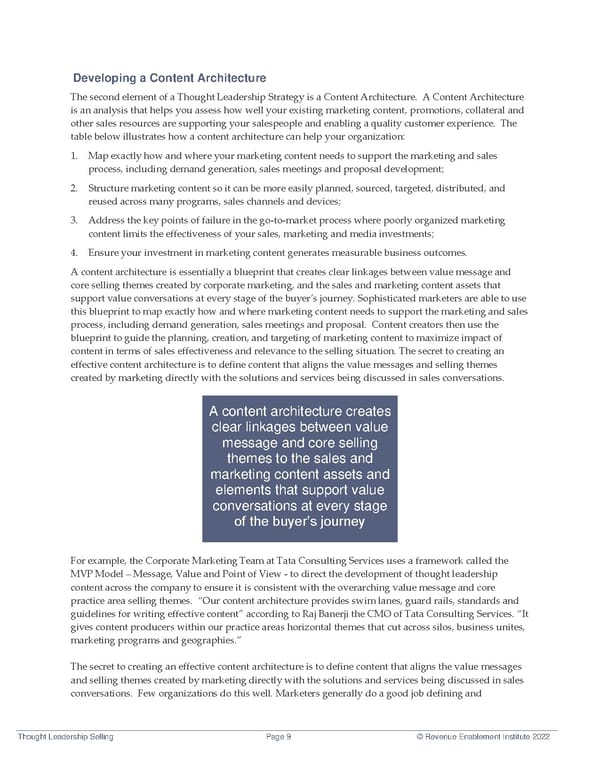Developing a Content Architecture The second element of a Thought Leadership Strategy is a Content Architecture. A Content Architecture is an analysis that helps you assess how well your existing marketing content, promotions, collateral and other sales resources are supporting your salespeople and enabling a quality customer experience. The table below illustrates how a content architecture can help your organization: 1. Map exactly how and where your marketing content needs to support the marketing and sales process, including demand generation, sales meetings and proposal development; 2. Structure marketing content so it can be more easily planned, sourced, targeted, distributed, and reused across many programs, sales channels and devices; 3. Address the key points of failure in the go-to-market process where poorly organized marketing content limits the effectiveness of your sales, marketing and media investments; 4. Ensure your investment in marketing content generates measurable business outcomes. A content architecture is essentially a blueprint that creates clear linkages between value message and core selling themes created by corporate marketing, and the sales and marketing content assets that support value conversations at every stage of the buyer’s journey. Sophisticated marketers are able to use this blueprint to map exactly how and where marketing content needs to support the marketing and sales process, including demand generation, sales meetings and proposal. Content creators then use the blueprint to guide the planning, creation, and targeting of marketing content to maximize impact of content in terms of sales effectiveness and relevance to the selling situation. The secret to creating an effective content architecture is to define content that aligns the value messages and selling themes created by marketing directly with the solutions and services being discussed in sales conversations. A content architecture creates clear linkages between value message and core selling themes to the sales and marketing content assets and elements that support value conversations at every stage of the buyer’s journey For example, the Corporate Marketing Team at Tata Consulting Services uses a framework called the MVP Model – Message, Value and Point of View - to direct the development of thought leadership content across the company to ensure it is consistent with the overarching value message and core practice area selling themes. “Our content architecture provides swim lanes, guard rails, standards and guidelines for writing effective content” according to Raj Banerji the CMO of Tata Consulting Services. “It gives content producers within our practice areas horizontal themes that cut across silos, business unites, marketing programs and geographies.” The secret to creating an effective content architecture is to define content that aligns the value messages and selling themes created by marketing directly with the solutions and services being discussed in sales conversations. Few organizations do this well. Marketers generally do a good job defining and Thought Leadership Selling Page 9 © Revenue Enablement Institute 2022
 Thought Leadership Selling Flipbook Page 8 Page 10
Thought Leadership Selling Flipbook Page 8 Page 10